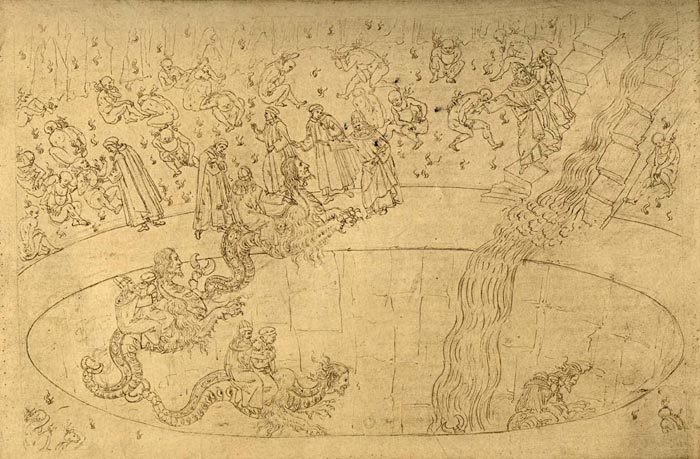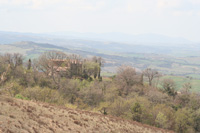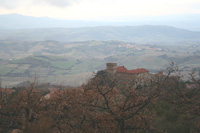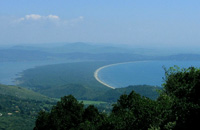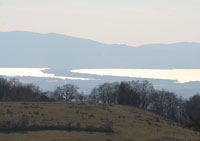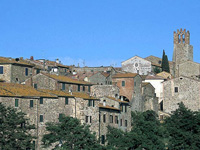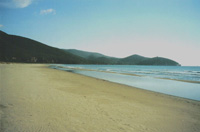| |
|
| |
|
|
|
|
|
|
| |
 |
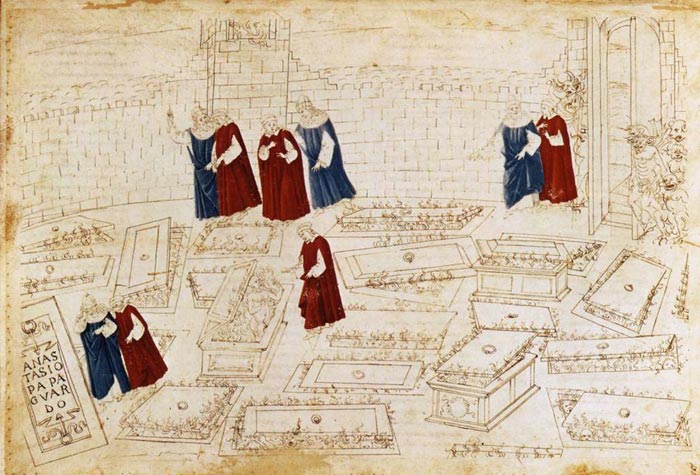 |
| Sandro Botticelli, llustration to the Divine Comedy (Inferno), 1480s, Silverpoint on parchment, completed in pen and ink, coloured with tempera.
Biblioteca Apostolica Vaticana, Rome |
|
 |
 |
| |
|
|
|
| |
|
Sandro Botticelli | Illustrations for Dante’s Divine Comedy
|
|
|
|
| |
|
The manuscript of the Dante's "Commedia" was embellished by 92 drawings made by Sandro Botticelli between ca 1485 and 1495. It is characterized by the very tight connection between the text parts and the adequate illustrations depicting the scenes in the fullest detail, what reminds the cedexes. A number of the structural innovations were introduced in the volume. Each canto, illustrated by one all-page set of drawings, is contained on one page what was allowed by removal of the commentary. Book was probably opened vertically what is understandible from the practical reasons. This also gave a special significance to the miniatures of the "Plan of Hell" and Lucifer clasping the book's course. General project of the manuscript's form is due to S. Botticelli who used here the ideas first introduced in his designs of the engravings for the Florentine edition of "Commedia" (1841).
Sandro Botticelli began illustrating Dante’s Divine Comedy at the request of Lorenzo di Pier Francesco di Medici around 1490. His drawings let us share the Florentine artist’s fascination for this masterpiece of poetry and humanism from the imagination of Dante Alighieri.
Thoroughly steeped in Dante’s poems, Botticelli produced some very detailed illustrations on parchment on the back of the manuscript calligraphed by Nicolaus Mangona between 1481 and 1503. Work on parchment usually started with a design marked out with a stylet, corrected and reworked in metal point. Next, just the outlines and key lines of the basic design of the miniature were given an opaque greyish-brown primer with a brush, allowing the possibility of minor corrections. All these steps, including that of colouring-in, demonstrate a constant evolution towards increasingly perfect forms executed by Botticelli’s hand.
For some reason unknown to us, the drawings were never completed. Only four of the surviving 93 sheets - nine having been lost in the course of time - are coloured, although this was presumably the original intention for all of them. The drawings are now in the collections of the Staatliche Museen in Berlin and the Vatican Library.
|
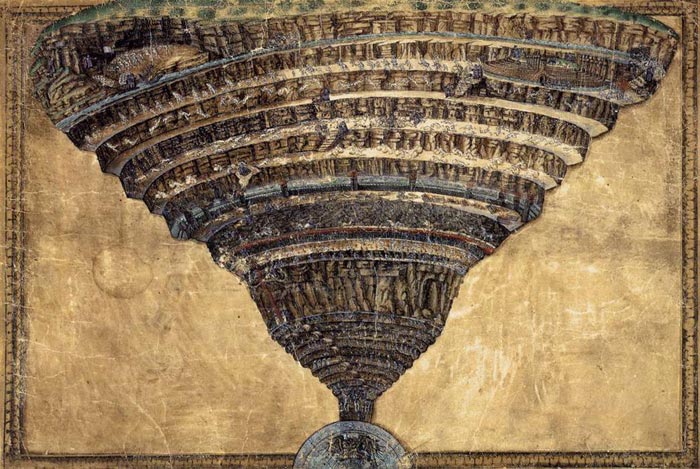 |
Sandro Botticelli, The Abyss of Hell, 1480s, coloured drawing on parchment, 320 x 470 mm.
Biblioteca Apostolica Vaticana, Rome
|
| History
Sandro Botticelli’s illustrations for Dante’s Divine Comedy were split up into several parts and have had a very chequered history. Of the original 100 drawings, lost until the 17th century, only 92 have so far been found.
A first part, consisting of the illustrations for Cantos I, VIII, IX, X, XII, XIII, XV and XVI of Hell, were found in the Vatican Library, with a composition on a header sheet depicting the set of circles of Hell. These 9 drawings were in a volume of miscellanies that had been in Christine of Sweden’s collection of manuscript. Today, they are preserved at the Vatican, in the oldest and least-accessible library in the world.
A second part, comprising 83 drawings, was identified at a Paris bookseller's in the 19th century. It the passed through the hands of the Duke of Hamilton, before being bought in 1882 by the King of Prussia’s curator for the Berlin Royal Drawing & Print Collection. After WWII, this part was split up and preserved in 2 different museums, because of the building of the Berlin Wall. Since 1993, the 83 drawings have been reunited and are preserved in Berlin’s prestigious Drawing & Print Collection. |
|
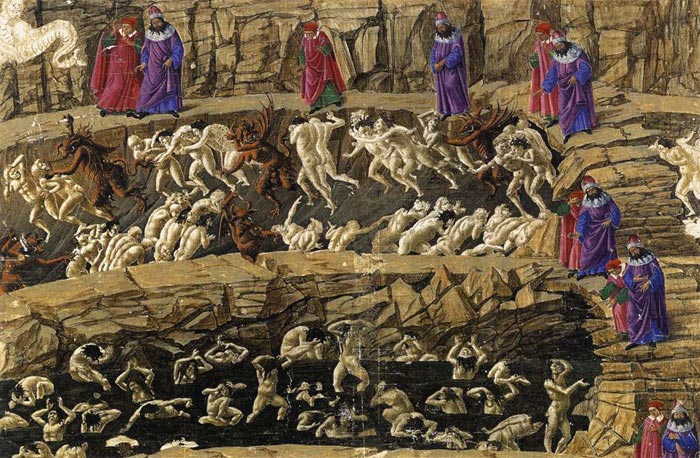 |
Sandro Botticelli, Inferno, Canto XVIII, 1480s, coloured drawing on parchment, 320 x 470 mm, Staatliche Museen, Berlin
We see Dante with Virgil, his guide, in the eighth circle, which consists of ten deep chasms in which those guilty of fraud are punished.
In the Comedy, the eminent Latin poet Virgil acquires a second life. Author of the Aeneid and the master of poetry revered by Dante and the entire Middle Ages, Virgil materializes out of nowhere to become Dante's guide through Inferno and most of Purgatory. Dante honors Virgil as the glory and light of other poets. The German scholar Curtius remarked: "The awakening of Virgil by Dante is an arc of flame which leaps forth from one great soul to another."
|
|
|
|
| |
|
The drawing, which covers the whole surface of the folio, represents a cross-section of Dante's vision of HelI and summarizes, in a manner of speaking, the most significant episodes of the poetic journey that Dante Alighieri, accompanied by his guide Virgil, imagined taking in the underworld, 50 wonderfully related in the first part of his celebrated poem, the Divina Commedia. Executed with the care of a miniaturist and subsequently coloured, the drawing opens the copy of the Commedia commissioned from Botticelli by Lorenzo di Pierfrancesco de' Medici, cousin of the better-known Lorenzo the Magnificent and head of the cadet branch of the family, and constitutes not just a unique and significant episode in the history of Florentine art, but also bi the history of book illustration. The name of the client is recorded by the writer known as the Anonimo Magliabechiano (Biblioteca Nazionale Centrale, Florence, Magliab. XVII. 17, c. 48 recto), who says of Botticelli that "he painted and decorated with figures a Dante on parchment for Lorenzo di Piero Francesco de' Medici, which was a marvelously done thing". This fact does not seem to have been known to Vasari, who speaks solely of the great deal of time Botticelli devoted to the edition of the Divina Commedia, with a commentary by Cristoforo Landino, that was printed in Florence in 1481 on the presses of Niccolo di Lorenzo della Magna, for which the Florentine painter had provided the drawings for the engravings (Scapecchi, in Sandro Botticelli 2000).
Sandro Botticelli had close ties with Lorenzo di Pierfrancesco, for whom he had painted some wonderful pictures, such as the Primavera and the Pallas and the Centaur (Lightbown 1989, p. 122; cat. no. ll). The shift from a mythological theme to a more typically religious one -- it should not be forgotten that Alighieri's poem is considered the pinnacle of Christian poetry-probably took place in the fiery climate of Savonarola's preaching, which had a powerful influence on both the artist and his client. And it is to around that time, i.e. the 1490s, that the parchments illustrated by Botticelli are generally ascribed, although the problem of the dating of this manuscript is far more complicated, and its execution may even have overlapped with that of the aforementioned printed edition: it is certain that Botticelli worked on it for many years, with continual interruptions, and without finishing it in the end.
The manuscript of the Divina Commedia illustrated by Sandro Botticelli is something unique in the book's history. Generally it has the text on the recto of each folio, i.e. one canto for each sheet, while on the verso is set the drawing relating to the next canto, in such a way that the. text and its illustration could be seen at the same time when the book was open. As the fact that many of the drawings were left in the state of mere sketches suggests, the volume was never finished, perhaps as a result of Lorenzo di Pierfrancesco's voluntary exile from Florence in 1497-98.
A case apart is the folio with the view of Dante's Inferno, which has another drawing on the back relating to the first canto of the poem, of which unfortunately little is now visible. The folio on show here must have originally been intended to serve as the title page of the volume, as is implied by the elaborate frame, highlighted in gold and then partly covered at the top and bottom by the drawing itself (MoreIlo, in Sandro Botticelli 2000). This suggests that the drawing must have been made after the gilded frame. indeed it can be said with some confidence that it was executed after Botticelli had completed the other drawings of the Inferno, as many details of the scene appear to be modelled directly on the figures and buildings present in the drawings on the other sheets (reproduced here in miniature). In his representation of Dante's Inferno Botticelli has come up with a highly imaginative invention: rather than a cross-section of the infernal realm, as it is commonly described, what we. have here is a three-dimensional image, a sort of painted sculpture that seems about to detach itself from the plane of the folio and float in space. It was an utterly new way of representing Dante's work, and has no known precedents: the artist has presented HeIl as a great inverted funnel, whose upper part fills almost the whole width of the sheet, gradually narrowing toward the bottom and terminating, in the middle of the lower part of the page, with the representation of Satan, enclosed and raised in a semicircle. It is a device that allows us to make sense of a scene that would otherwise not be very comprehensible, almost as if the artist were using a modem cinematographic zoom.
The folio with the view of HeIl, along with the other six in the Biblioteca Apostolica Vaticana, comes from the collection of Queen Christina of Sweden. She had bought them from the Parisian collector and bibliophile Alexandre Peteau, who in 1632 had applied his ex-libris to the miscellaneous volume that contains the drawings. Subsequently Queen Christina's library was acquired by Pope Alexander VIII Ottoboni and transferred to the Vatican.
The other eighty-five folios that have come down to us, now in the Kupferstichkabinett
in Berlin, which together with the seven in the Vatican bring the total number of surviving folios out of the hundred initially planned by Botticelli for the illustration of
the Commedia to ninety-two, were also in the French capital for a while. It was in fact there that they were purchased by the duke of Hamilton, sometime before 1819, from the bookseller Giovanni Claudio Molini, Parisian by adoption. In 1882 the parchments illustrated by Botticelli were acquired in London by Friedrich Lippmann, acting on behalf of the Prussian government (Schulze Altcappenberg, in Sandro Botticelli 2000). Only recently have all of Botticelli's surviving drawings for the Divina Commedia been assembled and put on show together, first in BerIin and then in Rome and London, at a major exhibition.[2]
|
|
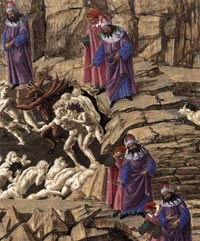 Sandro Botticelli, Inferno, (detail), Staatliche Museen, Berlin Sandro Botticelli, Inferno, (detail), Staatliche Museen, Berlin
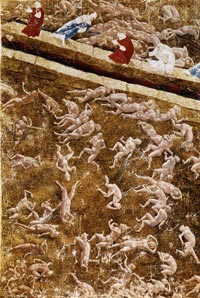 Sandro Botticelli, Inferno, (detail), Staatliche Museen, Berlin Sandro Botticelli, Inferno, (detail), Staatliche Museen, Berlin
|
|
|
|
|
Dante's Inferno, widely hailed as one of the great classics of Western literature, details Dante's journey through the nine circles of Hell. The voyage begins during Easter week in the year 1300, the descent through Hell starting on Good Friday. After meeting his guide, the eminent Roman poet Virgil, in a mythical dark wood, the two poets begin their descent through a baleful world of doleful shades, horrifying tortures, and unending lamentation.
This detail from the thirty-fourth and final Canto depicts three-headed Lucifer, engaged in crushing the three greatest sinners of mankind, namely Brutus and Cassius - Caesar's murderers - as well as Judas, who betrayed Christ.
|
|
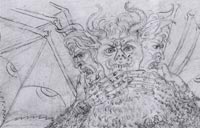
Inferno, Canto XXXIV (detail), 1480s, Silverpoint on parchment, Staatliche Museen, Berlin
|
As Dante explains in the opening lines of the canticle, Purgatory is the place in which "the human spirit purges himself, and climbing to Heaven makes himself worthy." Dante's Purgatory consists of an island mountain, the only piece of land in the southern hemisphere. Divided into three sections, Antepurgatory, Purgatory proper, and the Earthly Paradise, the lower slopes are reserved for souls whose penance was delayed. The upper part of the mountain consists of seven terraces, each of which corresponds to one of the seven capital sins. Atop the mountain Dante locates, Eden, the Earthly Paradise, the place where the pilgrim is reunited with Beatrice, the woman who inspired the poem.
Dante and Virgil climb up between rock crevices to the first circle of purgatory. They admire reliefs depicting deeds of exemplary humility on the huge marble walls: the Annunciation to Mary, the dance of David in front of the Ark of the Covenant and the justice of the Emperor Trajan. Two of the proud are creeping up from the right, bent beneath the weight of heavy stones.
|
|
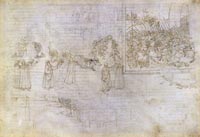
Sandro Botticelli, Purgatory X, 1490s, Staatliche Museen, Berlin |
The third realm of the afterlife details Dante's voyage through the nine spheres of Paradise. Following medieval cosmology, Dante's presentation of the planetary system broadly follows the Ptolemaic geometric model. Beatrice guides Dante successively through the nine spheres, each of which carries a heavenly body which orbits the earth: in succession they include the Moon, Mercury, Venus, Sun, Mars, Jupiter, Saturn and Fixed Stars. The voyage culminates in a vision of God in the Empyrean, the realm of pure light.
In the Empyrean, the upper heaven, Dante and Beatrice are carried upwards in a river of light, from which fly sparkles which Botticelli depicts as little putti. They disappear in the meadows of flowers along the banks on either side. The one on the right had not been retraced with ink and was a preliminary drawing carried out in silver point. |
|
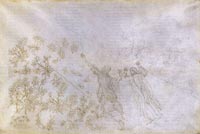
Sandro Botticelli, Paradise, Canto XXX
1490s, Drawing on parchment, Staatliche Museen, Berlin
|
| |
| |
|
|
|
|
| |
|

Art in Tuscany | Dante Alighieri
World of Dante | World of Dante Multimedia website that offers Italian text of Divine Comedy, Allen Mandelbaum's translation, gallery, interactive maps, timeline, musical recordings, and searchable database for students and teachers by Deborah Parker and IATH (Institute for Advanced Technologies in the Humanities) of the University of Virginia.
Princeton Dante Project | Princeton Dante Project Website that offers the complete text of the Divine Comedy (and Dante's other works) in Italian and English along with audio accompaniment in both languages. Includes historical and interpretive annotation.
Sandro Botticelli: the Drawings for Dante's Divine Comedy, with essays by Hein.-Th. Schulze Altcappenberg, Horst Bredekamp, Damian Dombrowski, Andreas Kablitz, Peter Keller, Giovanni Morello, Julia Schewski, Robert Fuchs, Oliver Hahn and Doris Oltrogge.
Published in London by the Royal Academy of Arts.
Peter Dreyer, Sandro Botticelli, Illustrationen zu Dantes Gottlicher Komodie (Bilderheft der Staatlichen Museen Preussischer Kulturbesitz) (German Edition), 1988
Kenneth Clark, The Drawings of SANDRO BOTTICELLI for Dante's Divine Comedy. After the originals in the Berlin Museums and the Vatican, 1976
Robert Hollander, Dante's Virgil | Expanded version of the article "Virgil" in the Dante Encyclopedia, ed. Richard Lansing, New York, Garland Publishing, Inc., 2000.
Sandro Botticelli's Drawings for Dante's "Inferno": Narrative Structure, Topography, and Manuscript Design, Barbara J. Watts in Artibus et Historiae, Vol. 16, No. 32 (1995), pp. 163-201
Gallery Sandro Botticelli - Wikimedia Commons | Sandro Botticelli | Illustrations to the Divine Comedy
Digital Dante: Library: Image Collections | Images to the Divine Comedy by Botticelli
The World of Dante | www.worldofdante.org/gallery_botticelli.html
By the time of his death Botticelli had fallen out of fashion and remained largely forgotten until his rediscovery in the late nineteenth century. From that time on, he has been appreciated primarily for the delicacy, gracefulness, and linear beauty of his mythological works from the 1480s, the Primavera and the Birth of Venus. Both of these works reveal not only Botticelli's poetic sensibilities, but his contact with Florentine poets
Giorgio Vasari, our most important early source on Botticelli, wrote in 1550 that "Since Botticelli was a learned man, he wrote a commentary on part of Dante's poem, and after illustrating the Inferno, he printed the work." Vasari refers Botticelli's drawings for some of the engravings by Baccio Baldini that adorned the first edition of the Divine Comedy published in Florence, in 1481, with commentary by Cristoforo Landino. Botticelli also painted a portrait of the poet, probably to adorn the library of a scholar. These two projects reflect the revival of interest in Dante in late fifteenth-century Florence.
An anonymous author, writing in about 1540, informs us that Botticelli "painted and illustrated a Dante on sheepskin for Lorenzo di Pierfrancesco de' Medici [who also owned the Primavera] which was held to be something marvelous." He refers to an extraordinarily ambitious and original project. Whereas previous artists had decorated manuscripts of the Divine Comedy, usually with small images of a few key scenes that appeared on the same page as the text, Botticelli planned to illustrate every canto. Moreover, the drawings are very large, arranged horizontally (unlike most books) and full the entire smooth (flesh) side of the parchment. Originally, the images could be seen together with the text, written by Niccolò Mangona on the opposite (rough) side of the parchment. Of this project 92 parchment sheets survive, divided between Berlin and the Vatican. Botticelli completed the outline drawings for nearly all the cantos, but only added colors for a few. The artist shows his "learning" and artistic skill by representing each of the three realms each in a distinctive way. More than his contemporaries, Botticelli was extremely faithful to Dante's text. Moreover, especially in the teaming, bewildering images of the Inferno, he included a large number of scenes for each canto. For the Purgatorio, Botticelli was somewhat more selective and made greater use of "rational" perspective: for the Paradiso, his simplified drawings capture the ethereal nature of the text. Botticelli also created a highly detailed cross section map of the underworld, and a frightening portrayal of Satan on a double sheet.
[]Jonathan K. Nelson Syracuse University in Florence | www.worldofdante.org]

[1] In 1481, Pope Sixtus IV summoned Botticelli and other prominent Florentine and Umbrian artists to fresco the walls of the Sistine Chapel. The iconological program was the supremacy of the Papacy. Sandro's contribution was moderately successful. He returned to Florence, and "being of a sophistical turn of mind, he there wrote a commentary on a portion of Dante and illustrated the Inferno which he printed, spending much time over it, and this abstention from work led to serious disorders in his living." Thus Vasari characterized the first printed Dante (1481) with Botticelli's decorations; he could not imagine that the new art of printing might occupy an artist.
[2] Giovanni Morello, in Botticelli: From Lorenzo the Magnificent to Savonarola, Skira, Milano 2003, p. 114. Catalogue published in conjunction with the major Fall 2003 exhibition organized by the Musée du Luxembourg in Paris.
Fra Girolamo Savonarola, a Dominican Friar who rose to power in the late 1400 s and significantly influenced politics, religion, and art in Florence, Italy. To art historians there is much speculation concerning the specific effect of Savonarola on the artists in Florence during his power over the Florentine religion, politics, and art in Florence s late 1400s and early 1500s. Due to the Savonarolan influence it is alleged that Allesandro Botticelli transformed his once Renaissance Humanitarian philosophies in his artwork toward a more Savonarolan iconography.

Podere Santa Pia is an old farm that has been renovated into a perfect holiday house located 350 meters above sea level in a panoramic position. Podere Santa Pia is just outside the town walls of Castiglioncello Bandini, a typical medieval borgo in the province of Tuscany and an excellent base for making excursions.Even today the Maremma remains a largely undiscovered gem in the heart of Italy, sandwiched between the stunning Monte Amiata on its eastern fringes and the beautiful Tyrrhenian coast to the west.
The Val d'Orcia, a place where to admire both the enchanting landscapes and the picturesque towns of the Tuscan countryside, is within easy reach. Experience the best of Tuscany on day tours to Montalcino, Montepulciano, Scansano and the surreal beauty of the Val D'Orcia, and enjoy wine tastings of the famous Brunello, Montecucco and Montepulciano wines.
More to the south are Roccalbegna, Saturnia, Pitigliano, Saturnia, Sovana and Sorano.
Holiday houses in Tuscany | Podere Santa Pia | Residency in Tuscany for writers and artists
|
| |
|
|
|
|
|
|
|
|
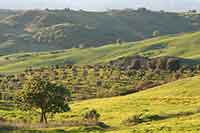
|
Podere Santa Pia |
|
Castiglioncello Bandini |
|
Century-old olive trees, between Podere Santa Pia and Cinigiano |
| |
|
|
|
|
|
|
|
|
|
Tombolo di Feniglia |
|
Monte Argentario, view from Scansano |
|
Campagnatico |
| |
|
|
|
|
|
|
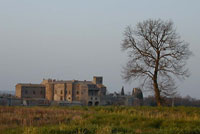
|
|
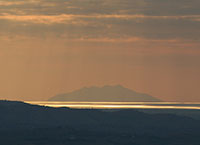
|
Alberese |
|
Montecalvello |
|
Sunsets in Tuscany
|
| |
|
|
|
|
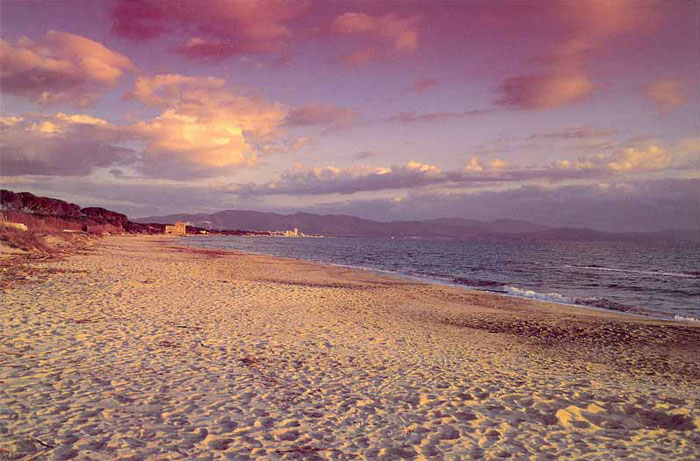 |
Torre Mozza beach
|
The Tyrrhenian coast offers many beautiful beach resorts where you can spend a relaxing day at the beach (1 hour drive).
Podere Santa Pia is suitably located only 20 kilometers from Paganico and the highway Grosseto - Siena.
You can easily reach some of the most beautiful beaches of Tuscany.
Tuscany Beaches in Maremma | [1] From Principina a Mare to Piombino
Tuscany Beaches in Maremma | [2] From Principina a Mare to Ansedonia
|
|
|
| |
|
|
|
| |
|
|
|
| |
|
|
|
| |
|
|
|
| |
|
|
|
| |
|
|
|



